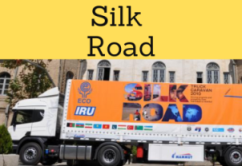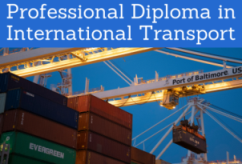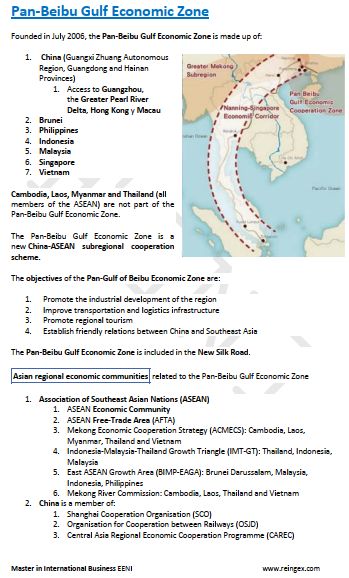Pan-Beibu Economic Zone

Pan-Beibu Gulf Economic Zone (China-ASEAN, Brunei, Philippines, Indonesia)
- Introduction to the Pan-Beibu Gulf Economic Zone
- Countries of the Pan-Beibu Gulf Economic Zone: China, Vietnam, Malaysia, Singapore, Indonesia, Philippines and Brunei
- Main features of the Pan-Beibu Gulf Economic Zone
- The Pan-Beibu Gulf Economic Zone as a part of the New Silk Road
- Cooperation between the ASEAN and China: "One Axis, Two Wings"

The Subject «Pan-Beibu Gulf Economic Zone» belongs to the following Online Programs taught by EENI Global Business School:
Transportation Courses: Road, Railway, Air, Multimodal.

Diploma: International Transport.

Masters: International Transport, International Business.
Doctorate: Global Logistics, World Trade.
Languages:  .
Summary in
.
Summary in  Zona Económica del Pan-Golfo de Beibu
Zona Económica del Pan-Golfo de Beibu
 Zone économique du Pan-Golfe de Beibu (Chine ASEAN)
Zone économique du Pan-Golfe de Beibu (Chine ASEAN)  Zona Económica do Pan-Golfo de Beibu (China-ASEAN).
Zona Económica do Pan-Golfo de Beibu (China-ASEAN).
Pan-Beibu Gulf Economic Zone.
Founded in July 2006, the Pan-Beibu Gulf Economic Zone is made up of:
- China (Guangxi Zhuang Autonomous Region, Guangdong and Hainan Provinces)
- Access to Guangzhou, the Greater Pearl River Delta, Hong Kong and Macau
- Brunei
- Philippines
- Indonesia
- Malaysia
- Singapore
- Vietnam
Pan-Beibu Gulf Economic Zone

Cambodia, Laos, Myanmar and Thailand (all members of the ASEAN) are not part of the Pan-Beibu Gulf Economic Zone.
The Pan-Beibu Gulf Economic Zone is a new China-ASEAN subregional cooperation scheme.
The objectives of the Pan-Gulf of Beibu Economic Zone are:
- Promote the industrial development of the region
- Improve transportation and logistics infrastructure
- Promote regional tourism
- Establish friendly relations between China and Southeast Asia
The Pan-Beibu Gulf Economic Zone is included in the New Silk Road.
Asian regional economic communities related to the Pan-Beibu Gulf Economic Zone.
- ASEAN
- ASEAN Economic Community
- ASEAN Free-Trade Area
- Mekong Economic Cooperation: Cambodia, Laos, Myanmar, Thailand and Vietnam
- IMT-GT: Thailand, Indonesia, Malaysia
- East ASEAN Growth Area: Brunei, Malaysia, Indonesia, Philippines
- Mekong River Commission: Cambodia, Laos, Thailand and Vietnam
- China is a member of:
- Greater Mekong Subregion: Cambodia, China, Laos, Myanmar, Thailand and Vietnam
- Indian-Ocean Rim Association
- Asia: Australia, Bangladesh, India, Indonesia, Iran, Malaysia, Sri Lanka, Singapore, and Thailand
- Middle East: Oman, the Emirates, and Yemen
- Africa: Comoros, Kenya, Madagascar, Mauritius, Mozambique, the Seychelles, South Africa, and Tanzania
- Asia-Pacific Trade Agreement: Bangladesh, China, India, South Korea, Laos, Mongolia and Sri Lanka
- APEC: Australia, Brunei Darussalam, Canada, Chile, China, South Korea, United States, Philippines, Hong Kong, Indonesia, Japan, Malaysia, México, New Zealand, Papua New Guinea, Peru, Russia, Singapore, Thailand, Taiwan, Vietnam
Access to the Bangladesh-China-India-Myanmar Corridor.
Trade Agreements related to the countries of the Pan-Beibu Gulf Economic Zone
- ASEAN
- ASEAN Trade Agreements: China, Canada, Australia-New Zealand, India, the EU, South Korea, Russia, the U.S., Pakistan, Japan..
- Singaporean Trade Agreements: Australia, China, Jordan, India, Japan, Korea, New Zealand, Panama, Peru, EFTA, U.S...
- Indonesia has a Trade Agreement with India
- EFTA-Philippines
- Chinese Trade Agreements: the ASEAN, Singapore, Pakistan, New Zealand, Peru, Costa Rica, APEC, SCO, Asia-Pacific Trade Agreement, the EU, Andean Community..
Main Asian institutions related to the Pan-Beibu Gulf Economic Zone
- ESCAP
- Asian Development Bank (ADB)
Main Islamic institutions related to the Pan-Beibu Gulf Economic Zone
- OCI
- Islamic Development Bank
The main Religions of the region of the Pan-Beibu Gulf Economic Zone are:
The Pan-Beibu Gulf Economic Zone belongs to:
- Sinic Economic Area
- Buddhist Economic Area
(c) EENI Global Business School (1995-2024)
We do not use cookies
Top of this page



